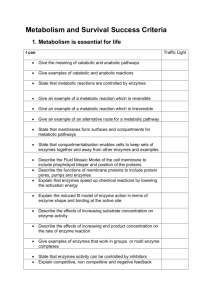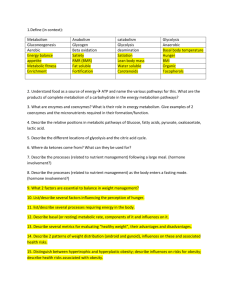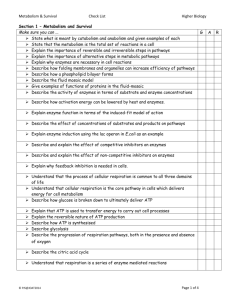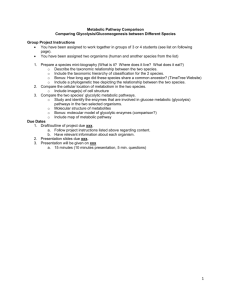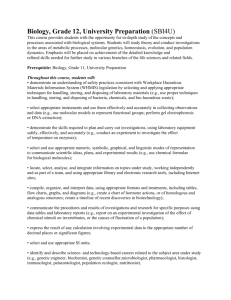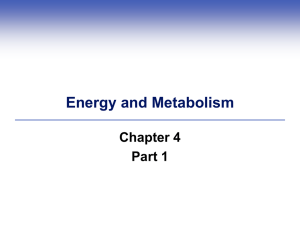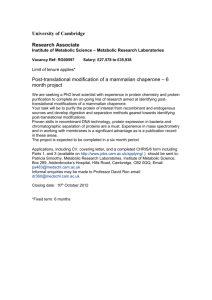Unit 2 Metabolism and Survival Summary
advertisement
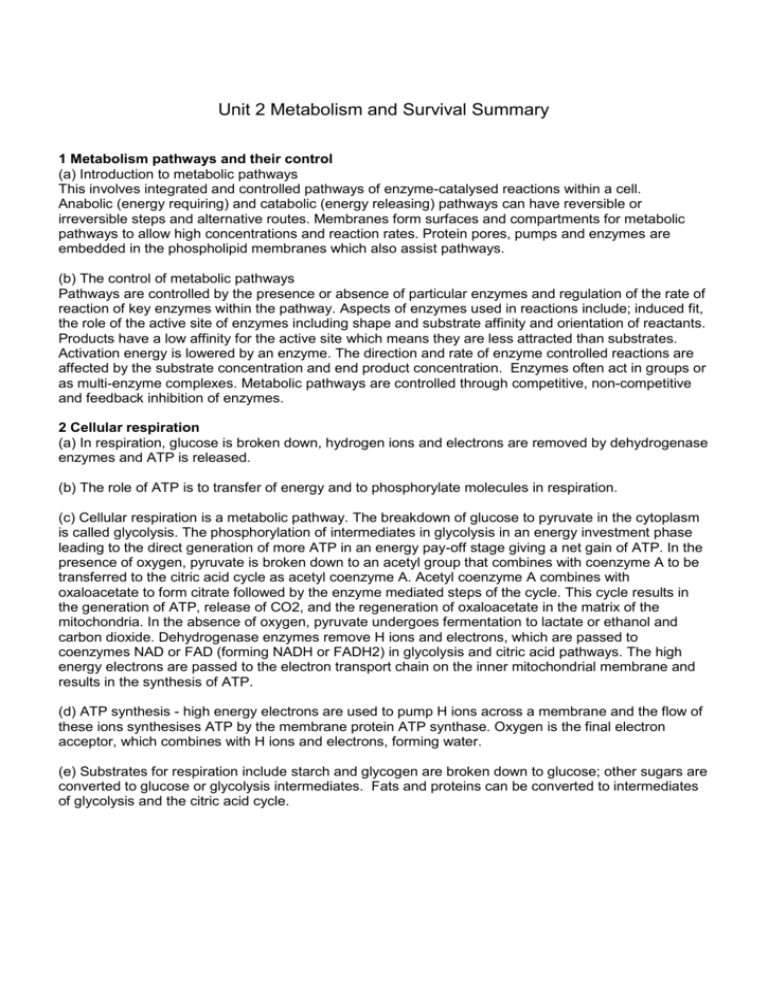
Unit 2 Metabolism and Survival Summary 1 Metabolism pathways and their control (a) Introduction to metabolic pathways This involves integrated and controlled pathways of enzyme-catalysed reactions within a cell. Anabolic (energy requiring) and catabolic (energy releasing) pathways can have reversible or irreversible steps and alternative routes. Membranes form surfaces and compartments for metabolic pathways to allow high concentrations and reaction rates. Protein pores, pumps and enzymes are embedded in the phospholipid membranes which also assist pathways. (b) The control of metabolic pathways Pathways are controlled by the presence or absence of particular enzymes and regulation of the rate of reaction of key enzymes within the pathway. Aspects of enzymes used in reactions include; induced fit, the role of the active site of enzymes including shape and substrate affinity and orientation of reactants. Products have a low affinity for the active site which means they are less attracted than substrates. Activation energy is lowered by an enzyme. The direction and rate of enzyme controlled reactions are affected by the substrate concentration and end product concentration. Enzymes often act in groups or as multi-enzyme complexes. Metabolic pathways are controlled through competitive, non-competitive and feedback inhibition of enzymes. 2 Cellular respiration (a) In respiration, glucose is broken down, hydrogen ions and electrons are removed by dehydrogenase enzymes and ATP is released. (b) The role of ATP is to transfer of energy and to phosphorylate molecules in respiration. (c) Cellular respiration is a metabolic pathway. The breakdown of glucose to pyruvate in the cytoplasm is called glycolysis. The phosphorylation of intermediates in glycolysis in an energy investment phase leading to the direct generation of more ATP in an energy pay-off stage giving a net gain of ATP. In the presence of oxygen, pyruvate is broken down to an acetyl group that combines with coenzyme A to be transferred to the citric acid cycle as acetyl coenzyme A. Acetyl coenzyme A combines with oxaloacetate to form citrate followed by the enzyme mediated steps of the cycle. This cycle results in the generation of ATP, release of CO2, and the regeneration of oxaloacetate in the matrix of the mitochondria. In the absence of oxygen, pyruvate undergoes fermentation to lactate or ethanol and carbon dioxide. Dehydrogenase enzymes remove H ions and electrons, which are passed to coenzymes NAD or FAD (forming NADH or FADH2) in glycolysis and citric acid pathways. The high energy electrons are passed to the electron transport chain on the inner mitochondrial membrane and results in the synthesis of ATP. (d) ATP synthesis - high energy electrons are used to pump H ions across a membrane and the flow of these ions synthesises ATP by the membrane protein ATP synthase. Oxygen is the final electron acceptor, which combines with H ions and electrons, forming water. (e) Substrates for respiration include starch and glycogen are broken down to glucose; other sugars are converted to glucose or glycolysis intermediates. Fats and proteins can be converted to intermediates of glycolysis and the citric acid cycle. 3 Metabolic rate (a) Measurement of oxygen consumption, carbon dioxide and heat production can be taken to compare metabolic rates of organisms. (b) Organisms with high metabolic rates require efficient delivery of oxygen to cells. The comparison between anatomy and physiology of heart chambers, circulation and lung arrangement in amphibians, reptiles, mammals and birds, and heart and circulation in fish and the differences correlate with the rate of metabolism in different organisms. (c) Physiological adaptations allow different animals to cope with low oxygen niches. (d) The use of maximum oxygen uptake (VO2Max) is a measure of fitness in humans. 4 Metabolism in conformers and regulators (a) The ability of an organism to maintain its metabolic rate is affected by external abiotic factors. (b) Conformers internal environment is dependent upon external environment. Conformers may have low metabolic costs and a narrow ecological niche. Behavioural responses are used to maintain optimum metabolic rate. (c) Regulators use metabolism to control their internal environment, which increases the range of possible ecological niches. Regulation requires energy to achieve homeostasis. (d) Negative feedback control and thermoregulation in mammals involves the use of the hypothalamus, nerves, effectors and skin to maintain a constant temperature. (e) Regulating temperature is important for optimal enzyme controlled reaction rates and diffusion rates to maintain metabolism. 5 Metabolism and adverse conditions (a) Some organisms can survive adverse conditions. To do this they reduce their metabolic rate. Dormancy is part of some organisms’ lifecycle and may be predictive or consequential. Examples of dormancy include hibernation and aestivation. Hibernation is often defined in terms of mammals. Aestivation allows survival in periods of high temperature or drought. Daily torpor as a period of reduced activity in organisms with high metabolic rates. (b) Some animals avoid adverse conditions by migration. Migration avoids metabolic adversity by expending energy to relocate to a more suitable environment. Long-distance migration studies have provided key information about migration. Migratory behaviour can be inbuilt (innate) or be learned from seeing other doing it. (c) Extremophiles- Some species have enzymes that are extremely tolerant and allow them to thrive in environments that would be lethal to almost all other species. Examples of extremophiles include thermophilic bacteria living in hot springs or seabed vents. 6 Environmental control of metabolism Microorganisms include archaea, bacteria and some species of eukaryotes. (a) Variations in growth media and control of environmental factors. Microorganisms require an energy source (chemical or light) and simple chemical compounds for biosynthesis. Many microorganisms can produce all the complex molecules required, including amino acids required for protein synthesis. Other microorganisms require more complex compounds to be added to the growth media, including vitamins and fatty acids. Culture conditions include sterility to eliminate any effects of contaminating microorganisms, control of temperature, control of oxygen levels by aeration and control of pH by buffers or the addition of acid or alkali. (b) Phases of microbe growth to include lag (enzymes induced), log/exponential, stationary (culture depleted and secondary metabolites produced) and death (lack of substrate and toxic accumulation of metabolites).Doubling or generation time give exponential growth. Changes in culture conditions affect microbe numbers directly. The viability (how successful it will be) of the culture and total cell count have to be taken into consideration. (c) Metabolism can be controlled through the addition of metabolic precursors, inducers or inhibitors to give a required product. Secondary metabolism can confer an ecological advantage by producing substances not associated with growth. 7 Genetic control of metabolism (a) Wild strains of microorganisms can be improved by mutagenesis, selective breeding and culture or recombinant DNA. Some bacteria can transfer plasmids or chromosomal DNA to each other or take up DNA from the environment to produce new strains. Fungi and yeast can produce new phenotypes by sexual reproduction. (b) Recombinant DNA (rDNA) technology, plasmids and artificial chromosomes. rDNA technology includes the use of restriction endonucleases, ligase, marker genes, restriction sites, origin of replication, selective markers and regulatory sequences. Genes can be introduced to confer an advantage. As a safety mechanism, genes are often introduced that prevent the survival of the microorganism in an external environment. Gene expression is controlled in recombinant plasmids and artificial chromosomes. Recombinant yeast cells are used to avoid polypeptides being folded incorrectly or lacking post translational modifications. 8 Ethical considerations in the use of microorganisms, hazards and control of risks. Things to consider when dealing with microorganisms include; potential contamination of original (wild) populations, potential harm to health of people working with the microorganisms, checking the final product is suitable for use on the public or whether it is right to transfer genes between different organisms.
